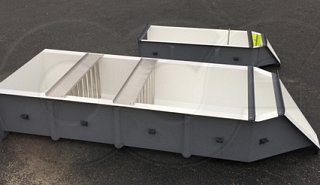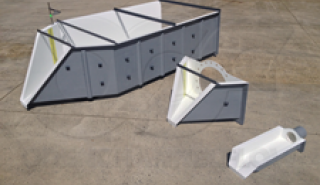The H Flume was developed to measure runoff in small experimental plots and agricultural watersheds. Like a weir, the H flume develops a backwater effect at higher flow rates. In low gradient applications, this backwater effect can cause flooding.
To minimize these effects, some researchers have suggested that H flumes be recessed into / below the bank of the plot or watershed by up to 70% of the flume’s depth. While recommended to avoid flooding and to aid into channeling flow into the flume, there has been little published on how this drop in the approach section impacts flow accuracy.

St. Anthony Falls Laboratory at the University of Minnesota undertook in 2010 to investigate approach flow conditions in H flumes. The study looked at a variety of approach lengths and drops into an H flume’s approach section. To mimic the approach conditions that might be experienced due to vegetation or snow melt, a triangular wedge was placed in the upstream channel.
Using a fiberglass 2-foot H flume, the Laboratory conducted a series of test with approaches of 2D, 3D, and 5D long, discharges of 1, 5, and 11 CFS [28.32, 141.6, and 311.5 l/s], and drops of 0.35D and 0.7D.
The results of the tests were as follows:
| Recessed Depth | Approach Section Length | Discharge (CFS) | Percent Error (%) |
| 0.35D | 2D | 1 | 10.7 |
| 0.35D | 2D | 5 | -0.2 |
| 0.35D | 2D | 11 | -3.3 |
| 0.35D | 3D | 1 | 5.3 |
| 0.35D | 3D | 5 | -0.2 |
| 0.35D | 3D | 11 | -2.1 |
| 0.35D | 5D | 1 | 4.9 |
| 0.35D | 5D | 5 | 1.3 |
| 0.35D | 5D | 11 | 1.7 |
| Recessed Depth | Approach Section Length | Discharge (CFS) | Percent Error (%) |
| 0.7D | 2D | 1 | 14.3 |
| 0.7D | 2D | 5 | 1.1 |
| 0.7D | 2D | 11 | 6.0 |
| 0.7D | 3D | 1 | 4.3 |
| 0.7D | 3D | 5 | -0.1 |
| 0.7D | 3D | 11 | 3.7 |
| 0.7D | 5D | 1 | 6.8 |
| 0.7D | 5D | 5 | 1.6 |
| 0.7D | 5D | 11 | 3.6 |
As expected, the drop into the recessed approach section introduced turbulence which inturn degraded the accuracy of the flow measurement in the flume. The larger drop (0.7D) introduced more turbulence and had a greater impact on the accuracy of the flow measurement, but not dramatically so (other than the low flow (1 CFS) experiment in the 2D approach section). Having a longer approach section did help dissipate the turbulent energy of the drop, but it did not completely dampen it.
For clean water applications (those without stringy vegetative mater) tranquilizing racks may be used to help further conditon the flow prior to it entering the H flume.
Image: HJ Andrews Experimental Forest
Sources: Brakensiek, D., Osborn, H., Rawls, W., Field Manual for Research in Agricultural Hydrology, Agriculture Handbook No. 224, February, 1979, Marr, J., Johnson, S., and Busch, D., Performance Assessment of H Flumes Under Extreme Approach Flow Conditions, Project Report No. 538, St. Anthony Falls Laboratory, University of Minnesota, March, 2010






